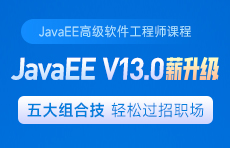concurrentHashMap和HashTable有什么区别?
更新时间:2023年06月23日09时18分 来源:传智教育 浏览次数:

ConcurrentHashMap和HashTable都是Java中用于存储键值对的数据结构,它们在功能上有一些相似之处,但也存在一些重要的区别。
1.线程安全性
·ConcurrentHashMap是线程安全的,多个线程可以同时对其进行读写操作而无需外部同步。
·HashTable也是线程安全的,但是它使用了一种全局锁机制,即每次对数据的读写都需要获取对象级别的锁,这会导致在并发情况下性能较差。
2.锁粒度
·ConcurrentHashMap使用了分段锁(Segment),它将整个数据结构分成多个小的段,每个段维护着一部分数据,并独立地进行加锁操作。这样不同的线程可以同时访问不同的段,从而提高并发性能。
·HashTable使用一把全局锁,这意味着在任何时候只能有一个线程访问数据结构,其他线程必须等待。
3.迭代器弱一致性
·ConcurrentHashMap的迭代器是弱一致的,即在遍历过程中,它能够反映出迭代器创建后的所有添加、删除和修改操作,但不提供对数据的准确快照。
·HashTable的迭代器是强一致的,它能够提供对数据的准确快照。
接下来笔者用一段具体的示例代码,演示一下ConcurrentHashMap和HashTable的使用:
import java.util.concurrent.ConcurrentHashMap;
import java.util.Hashtable;
public class ConcurrentHashMapVsHashTableDemo {
public static void main(String[] args) {
// 使用ConcurrentHashMap
ConcurrentHashMap<String, Integer> concurrentHashMap = new ConcurrentHashMap<>();
concurrentHashMap.put("A", 1);
concurrentHashMap.put("B", 2);
concurrentHashMap.put("C", 3);
// 线程安全的迭代
concurrentHashMap.forEach((key, value) -> System.out.println(key + ": " + value));
// 使用HashTable
Hashtable<String, Integer> hashTable = new Hashtable<>();
hashTable.put("A", 1);
hashTable.put("B", 2);
hashTable.put("C", 3);
// 线程安全的迭代
synchronized (hashTable) {
hashTable.forEach((key, value) -> System.out.println(key + ": " + value));
}
}
}
需要注意的是,虽然ConcurrentHashMap提供了更好的并发性能,但在单线程环境下,它的性能可能会略低于HashTable。因此,在不需要并发访问的情况下,使用HashTable可能更加合适。


















 AI智能应用开发(Java)
AI智能应用开发(Java) 鸿蒙应用开发
鸿蒙应用开发 HTML&JS+前端
HTML&JS+前端 Python+大数据开发
Python+大数据开发 人工智能开发
人工智能开发 跨境电商
跨境电商 电商视觉设计
电商视觉设计 软件测试
软件测试 新媒体+短视频
新媒体+短视频 集成电路应用开发
集成电路应用开发 C/C++
C/C++ 狂野架构师
狂野架构师 IP短视频
IP短视频





















